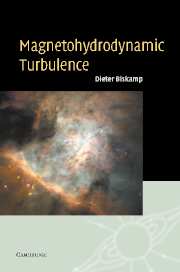Book contents
- Frontmatter
- Contents
- Preface
- 1 Introduction
- 2 Magnetohydrodynamics
- 3 Transition to turbulence
- 4 Macroscopic turbulence theory
- 5 Spectral properties and phenomenology
- 6 Two-point-closure theory
- 7 Intermittency
- 8 Two-dimensional turbulence
- 9 Compressible turbulence and turbulent convection
- 10 Turbulence in the solar wind
- 11 Turbulence in accretion disks
- 12 Interstellar turbulence
- Outlook
- References
- Index
3 - Transition to turbulence
Published online by Cambridge University Press: 17 August 2009
- Frontmatter
- Contents
- Preface
- 1 Introduction
- 2 Magnetohydrodynamics
- 3 Transition to turbulence
- 4 Macroscopic turbulence theory
- 5 Spectral properties and phenomenology
- 6 Two-point-closure theory
- 7 Intermittency
- 8 Two-dimensional turbulence
- 9 Compressible turbulence and turbulent convection
- 10 Turbulence in the solar wind
- 11 Turbulence in accretion disks
- 12 Interstellar turbulence
- Outlook
- References
- Index
Summary
One important aspect of turbulence theory is the need to understand how obviously random motions are generated from a smooth flow. There are essentially three approaches to this problem: the dynamic systems approach; the development of singular solutions of the ideal fluid equations, in particular the question of finite-time singularities; and the excitation of instabilities and their effects. The dynamic systems approach, i.e., the transition to a chaotic temporal behavior in some low-order nonlinear dynamic model such as the Lorentz model of thermal convection, had once been considered a very promising way to describe also the transition to turbulence in a fluid. However, these expectations have largely been frustrated, mainly because the low-order approximations of the fluid equations ignore the most important aspect of turbulence, namely the excitation and interactions of a broad range of different spatial scales. We will therefore not discuss dynamic systems theory in this treatise.
The problem of finite-time singularities has evoked considerable discussion. This is primarily a mathematical problem concerning the nature of the solution of the ideal fluid equations, whose relevance for the generation of turbulence in dissipative systems might be debatable. However, similarly to the theory of absolute equilibrium states of the ideal system considered in Section 5.2, which provides valuable information about the cascade dynamics in dissipative turbulence, the way in which the ideal solution becomes singular gives some indication of the spatial structure of eddies encountered in the dissipative system.
- Type
- Chapter
- Information
- Magnetohydrodynamic Turbulence , pp. 33 - 64Publisher: Cambridge University PressPrint publication year: 2003



